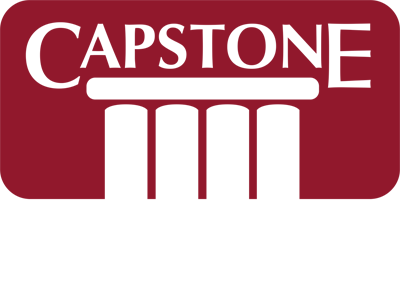Ankle Foot Orthosis
Low profile and Prefabricated
Indications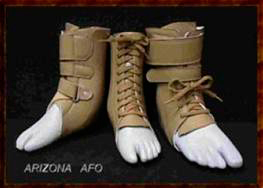
Indicated as a low profile option for rehabilitation of ankle sprains and minor fractures of the ankle and foot. Offers less support and stability than other options such as a CAM walker or AFO but provides a lower profile and therefore more cosmetic option. The amount of support and the design materials will vary depending on the exact brace that is chosen.
Examples include the following Arizona Brace.
Conventional vs. Total Surface Bearing
Total Surface Bearing/Thermoplastic is always preferable due to increased control areas and the reduced pressures on the skin that results. Therefore, the total surface bearing orthoses provide more comfort and better function than the conventional alternative. Total Surface Bearing/Thermoplastic designs are also considerably lighter, have a better durability/weight ratio, are easier to clean, and can easily be chance to different shoes.
Conventional AFOs can be a valuable tool, however, they are generally a last resort behind Total Surface Bearing/Thermoplastic or hybrid designs. Conditions that merit their use include conditions with fluctuating edema or fluid retention, or patient preference.
Conventional
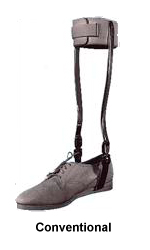 Indications
Indications
Conditions with fluctuating edema or fluid retention
Patient preference
Heat sensitivity – as seen occasionally with Multiple Sclerosis (thermoset or carbon braces are also an option)
Patient’s leg can not be casted or scanned – can only be traced or measured (very rare).
Contraindications
Cosmesis
Stirrups make changing shoes difficult
Advantages
Accommodates fluxuating edema better than total contact designs.
Only requires a tracing of the leg and measurements in order to fabricate.
Disadvantages
Higher pressures on the skin due to forces being applied to a relatively small surface area.
Less control is available due to reduced surface area.
Joints and uprights tend to be heavy
Cosmeticaly unappealing
Control of the foot relies on the shoe.
Total Surface Bearing/Thermoplastic
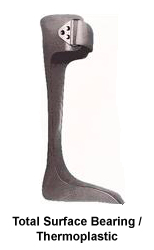 Indications
Indications
Any time significant changes in volume are not anticipated
Contraindications
When significant changes in volume are anticipated
Advantages
Increases control
Reduces pressures on the skin
More comfort
Considerably lighter
High durability/weight ratio
Easy to clean/ hygienic
Can easily be changed to different shoes.
Disadvantages
Does not accommodate for changes in volume as well as conventional systems
Dynamic type AFO
 Pros and Indications
Pros and Indications
- The most versital AFO that is designed.
- Can be made to be a Solid AFO to start and then move into a limited articulation, then change range of motion as rehabilitation dictates
- Controls medial/lateral stability at the ankle
- Controls the end points of dorsiflexion/plantar flexion range
- Does not necessarily interrupt the three rockers in stance phase of gait
- Excellent diagnostic orthosis during the post-trauma rehab period due to multiadjustable by therapist without use of any tools*. *Depending on joint type.
Cons / Contraindications
- Joint increments may not match anatomical changes.
- Difficult to apply with severe spastic varus or valgus deformity at the subtalar joint.
Solid Ankle AFO
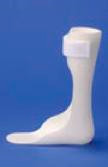 Pros and Indications
Pros and Indications
- Candidate who lacks medial/lateral control or stability at the ankle
- Candidate who has lacks active dorsiflexion and plantarflexion or has very limited or no range of motion
- Prevents foot drop by blocking plantar flexion
- Helps to control the knee by preventing hyperextension and/or hyperflexion (depending on the angle at the ankle)
- Note – may be indicated to help in knee instability or hyperextension. However, in significant cases, successful control of the knee joint may require going above the knee joint with a KAFO type design. Other design considerations are that if the patient only has hyperextension tendency at the knee, a Hinged AFO with plantarflexion stop should be considered since it would not unnecessarily block dorsiflexion. Or if a patient only has knee flexion instability, a Floor Reaction AFO can be considered as a more effective block of dorsiflexion.
- Decreases tone by maintaining a stretch on gastroc-soleus
- Assists push off by not collapsing into dorsiflexion
Cons and Contraindications
- Blocks range of motion. Therefore, may be excessive if orthotic objective does not require blocking plantarflexion, dorsiflexion, and inversion/eversion.
- Slows down forward progression. Note – this can be reduced by thinning out the foot plate distal to the metatarsal heads or adding a rocker bottom.
- Knee flexion/foot flat moment produced at heel strike/Perry’s first rocker. Note – this can be reduced by addition of a SACH heel.
- Fair quadriceps strength is required if set in dorsiflexion.
- Note – When there is a tendency for transverse plane problems (e.g. internal or external rotation of the foot), that tendency will typically be increased with an increased heel-toe lever arm. Avoid this problem by using a hinged AFO or thin the toe plate, or reduce the toe plate if possible.
Floor Reaction AFO
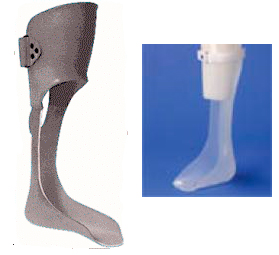 Function / Indication
Function / Indication
Same functions as solid AFO in frontal plane.
In the sagittal plane, provides significant knee extension moment during weight bearing/stance phase.
This can be an excellent alterative to a KAFO design for patients with trace or weak quadriceps in that it can achieve knee stability while maintaining efficiency by reducing weight and bulkiness.
Note – Articulated designs may help in allowing for more normal step length/gait by not unnecessarily blocking plantarflexion.
Often used with Crouch Gait.
Cons / Contraindications
- Recurvatum or unstable knee
- Knee extension moment compromised with external foot rotation in excess of 25 degrees.
- Presence of knee flexion contractures exceeding 15 degrees
- Must be able to get ankle to neutral or slight plantar flexion.
- Minimum of fair quadriceps strength needed if applied bilaterally (because the sound side allows the patient to know where they are placing the effected side).
- Presence of some trunk balance needed or ability to use walking side.
PTB AFO
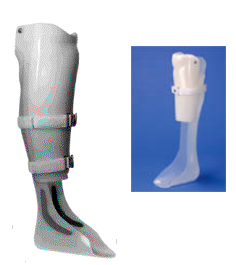 Function / Indication
Function / Indication
When significant deweighting of the ankle and foot is required.
Typically used for:
Fracture management
Arthritic joints
Painful conditions of the heel
Problems with ulceration
Cons / Contraindications
Conditions of skin and peripheral circulation which can not tolerate the pressure of the PTB.
Unstable knee joint
CROW Walker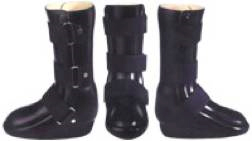
The C.R.O.W. is a combination of an ankle foot othosis and a custom boot. The C.R.O.W. was developed for patients with severe charcot changes of the foot and ankle where a more traditional means of treatment was not satisfactory. The device is in essence a bivalved copolymer full foot enclosure ankle foot orthosis with a rocker bottom sole built on the device.
The orthosis is fully lined with a custom foot insert and custom formed to a plastic impression of the patients affected limb. Appropriate modifications are performed to the impression, which permits for equal weight distribution through the limb and foot. The C.R.O.W. can be modified within limits to accommodate changes by flaring, adding padding and trimming where and when appropriate. It is very useful in protecting the patient from further breaks but not 100% as patients can and do fracture in plastic and fiberglass casts.
The C.R.O.W. is easy to don and doff. Patients can bathe daily and maintain proper hygiene. Many patients learn to drive with the C.R.O.W. Over all the acceptance is good due to availability of colors in the copolymers. The ability to bathe and sleep with freedom from a cast makes the C.R.O.W. a great asset.
